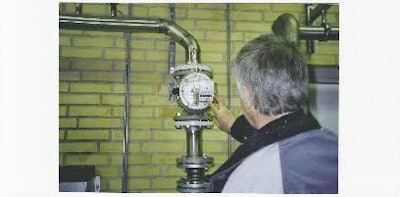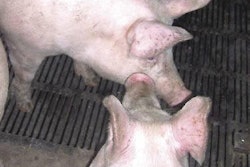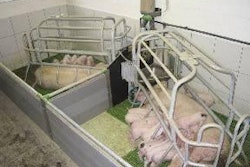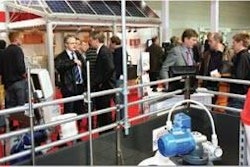
A highly desirable reduction in greenhouse gases from pig production sites is one of the benefits claimed from further moves in Europe to promote the conversion of pig manure into biogas, according to a report in our associated digital journal EcoAgri.biz. Financially, the idea is gaining ground after further indications by European governments that they will offer support as part of environmental initiatives and also increase the price paid to biogas users for the energy they supply.
The biggest single market in Europe currently for installations generating energy from agricultural products is Germany. The country is reported to have more than 3500 plants for anaerobic digestion to produce methane (biogas) from agricultural waste products and this total is now expected to grow by at least 30% over the next 12 months.
At the other extreme, biogas plants attached to pig units are much less common in Britain at present. But there have been reasons recently to think that this situation is changing.
One example emerged in comments to a conference organised by British breeding company ACMC. The head of one of the UK's largest pig production enterprises told the meeting about its project to incorporate biogas generation in a Green Circle pig production concept that will provide a renewable energy resource for the business.
Martin Barker, managing director of Midland Pig Producers, remarked that energy from manure might even become the main source of income for some pig units in the future, relegating pigmeat to the status of a by-product in terms of its financial contribution. The biogas plant being developed by Midland Pig Producers at a site in central England will process the manure from 52 000 finishing pigs as well as some 45 000 tons/year of waste food from catering that is being sourced from the local council for the area. Rated for size at 3 megawatts, it is projected to generate methane from which the resulting electricity should be worth about US$2 million per year. There will also be an extra revenue stream by saving on fees of about US$130 per ton which would normally apply to the disposal of the catering waste at a landfill site.
Furthermore, the odourless liquid obtained from processing the pig manure will be a valuable fertiliser for croplands. Mr Barker explained that his company is negotiating agreements with local farmers whereby they are supplied with free seed and fertiliser and in return sell grain to Midland Pig Producers at prices reflecting the value of the inputs. The fertiliser should be sufficient for 2000 hectares of arable land. producing enough grain for 15 000 tons of pig feed.
Even then the list of financial gains is not complete. Biogas generation produces heat and this can be captured for use in heating system in pig pens. The electricity from it methane, meanwhile, can be low-cost power for milling the grain in one-farm feed manufacturing.
Green Circle pig production will be based on a module of 2500 sows and progeny selling an average of 20.8 pigs per sow/year, according to Mr Barker's presentation. Building costs for the module will work out at around US$5000 per sow (including the places for the offspring), so the total investment envisaged is close to US$15 million.
Slurry from shallow pits under the pig pens will be flushed frequently into a holding tank using warm water. Since this means it retains the pigs' body temperature of 37oC, the effluent does not need further warming to prepare it for efficient biogas generation. The digester itself is in an underground concrete-box construction based on an American design. While frequent flushing stops odours from the slurry pits, exhaust air from the process will be drawn into a central pipe and both scrubbed and filtered to ensure it is odour-free.
Work on this first site started only recently, Mr Barker reported. But already there are more units along similar lines on the drawing board and awaiting planning permission.
Currently awaiting similar approval from the planners is a project for an 844 kW biogas plant to be built on a farrow-to-finish pig unit of 600 sows in south-west England. Costing about US$4 million, it will produce electricity on a continuous basis that will be eligible for a supplementary British government payment under an arrangement known as a single Renewables Obligation Certificate or ROC. EcoAgri.biz reports that this has been giving producers in Britain a price of about US$0.08 per kWh. However, a coming rule change in the UK is expected to allow green' electricity from biogas plants to qualify for double-ROC payments, making a significant impact on potential profit.
The plant in the Cornwall area of England has been ordered by farming company E H & B Dymond & Son from EnviTec Biogas UK Ltd. This is a joint venture between British pig housing manufacturer ARM Buildings Ltd and EnviTec Biogas AG of Germany, which was formed only last year and is already considered to be the largest constructor of biogas plants in Europe.
In Cornwall, the installation for producing biogas from pig manure will also have a section to separate raw slurry into solids and liquid. The more solid product from the process is to be marketed as a concentrated bio-fertiliser for soils. Heat produced from the biogas plant is to be supplied in the form of piped hot water to a development of 28 residential properties nearby. These eco-homes' will also be environment-friendly by having solar panels and green roofs.
To be managed by a new company called Fraddon Biopower Ltd, the new biogas facility will process all the slurry from the pig unit as well as accepting waste from local food processing firms. Also under consideration is the use of home-grown maize from the Dymond company's 600-acre arable enterprise. A further possibility is to use glycerol, a by-product of biodiesel production. PIGI

















